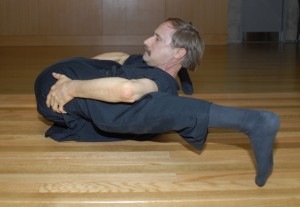Paulie Zink Workshop in Marin
/ Here is the info on a Paulie Zink workshop April 17th and 18th in Marin County, California. This is a bit difficult to write about because he is calling it Yin-Flow Yoga instead of calling it by it's actual name Daoyin. It's a weird problem, he wants to be able to teach his material and it nearly fits within the yoga class context, but if you read the text of the link you won't understand why this guy's stuff is so special. And because of that participant's expectations are going to be for yoga not Daoyin.
Here is the info on a Paulie Zink workshop April 17th and 18th in Marin County, California. This is a bit difficult to write about because he is calling it Yin-Flow Yoga instead of calling it by it's actual name Daoyin. It's a weird problem, he wants to be able to teach his material and it nearly fits within the yoga class context, but if you read the text of the link you won't understand why this guy's stuff is so special. And because of that participant's expectations are going to be for yoga not Daoyin.For those of you not familiar with Paulie Zink, he is the preeminent practitioner of Monkey Kungfu, he dominated the tournaments and exhibitions in the 1980's and I've yet to see a better performer of Monkey Kungfu. There are better acrobats out there and there are better contortionists, and there are possibly people who act a little more like monkeys than he does--but there is no one else I've seen who puts it all together the way he does. It's too bad he never had a whole troop to perform with. He does have a disciple now, so I'm hopeful that his lineage will get passed down.
 He credits his ability to years of train in the Daoyin system which he learned along with the Monkey Kungfu. This system is a combination of meditation techniques, some of them very old and shamanic like spending 4 hours balancing on only your knees and elbows staring at a flame, along with balancing, stretching, folding, rolling, exploding, pounding and scrapping. It is made up of animal imitation. Each animal has a whole series of meditations, postures, and forms of locomotion. It is the forms of locomotion that really sets it apart from a yoga class, but around half of the postures are quite similar to yoga postures. The difference is, his frog eats flies and hops, his bunny wiggles it's tail, and his downward-dog, scampers around the room and tries to lick people.
He credits his ability to years of train in the Daoyin system which he learned along with the Monkey Kungfu. This system is a combination of meditation techniques, some of them very old and shamanic like spending 4 hours balancing on only your knees and elbows staring at a flame, along with balancing, stretching, folding, rolling, exploding, pounding and scrapping. It is made up of animal imitation. Each animal has a whole series of meditations, postures, and forms of locomotion. It is the forms of locomotion that really sets it apart from a yoga class, but around half of the postures are quite similar to yoga postures. The difference is, his frog eats flies and hops, his bunny wiggles it's tail, and his downward-dog, scampers around the room and tries to lick people.I think of Daoyin primarily at a hermit practice done in conjunction with long periods of meditation. It is a capacity increasing tradition and is likely one of the roots of Chinese medicine. In his lineage it seems to have merged with a circus tradition. How did this happen? The answer is pretty simple but not widely understood, in fact I don't think Paulie Zink agrees with me on it. But any way here it is:
 Paulie Zink
Paulie ZinkThe most common and widespread form of religious experience in China was public Physical Ritual Theater (often called opera in English). There were quasi elite performing families which were part of a designated caste. These families were hated outsiders. It seems likely that Zink's teacher was from one of these families and taught a single outsider (an American) because he wanted to free the art from the tradition. In the South of China, where his tradition comes from, Daoist priests performed public rituals which included theater and theatrical components. So it's not hard to imaging that Daoists were working with performing troops and may have even apprenticed there sons and daughters to each other occasionally.
Anyway, if you've got the time, check out the workshop!
